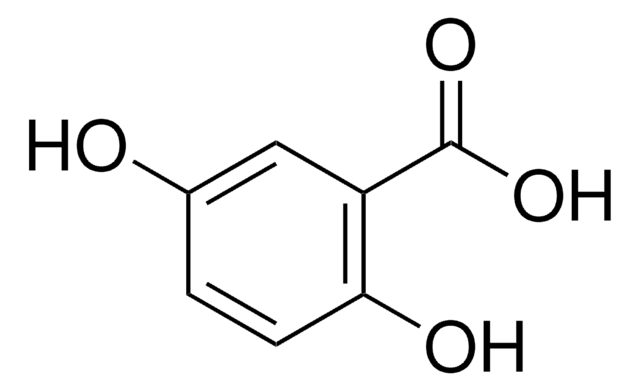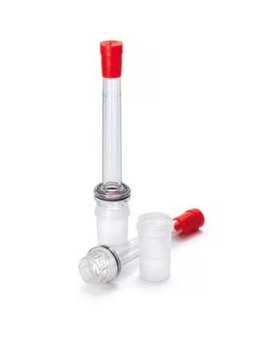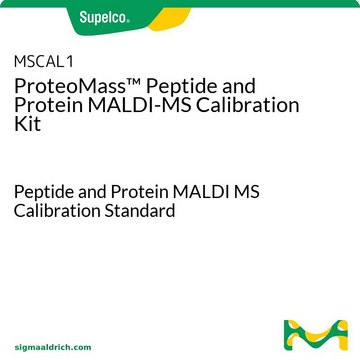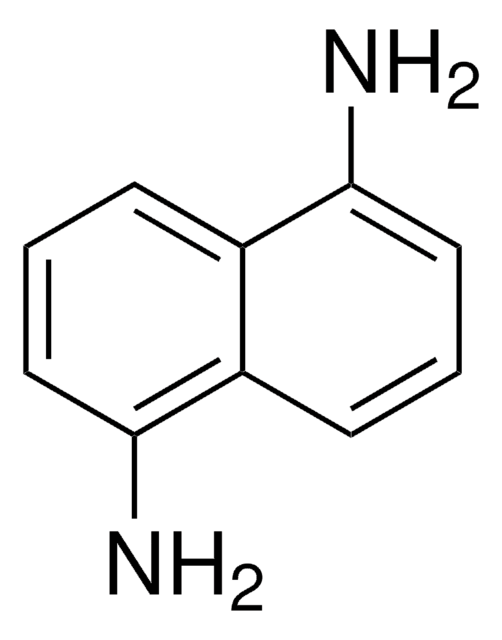49508
Sinapic acid
matrix substance for MALDI-MS, ≥99.5%, Ultra pure
Synonyme(s) :
3,5-Dimethoxy-4-hydroxycinnamic acid, 4-Hydroxy-3,5-dimethoxy-cinnamic acid, Sinapinic acid
About This Item
Produits recommandés
Qualité
matrix substance for MALDI-MS
Niveau de qualité
Pureté
≥99.5% (HPLC)
≥99.5%
Classe(s) chimique(s) de l'analyte
dendrimers, fullerenes, peptides, proteins
Technique(s)
MALDI-MS: suitable
Pf
~202 °C
Solubilité
dioxane: 1 g/10 mL at hot, clear, faintly yellow to yellow
Traces de cations
Al: ≤1 mg/kg
Ba: ≤1 mg/kg
Ca: ≤2 mg/kg
Cd: ≤1 mg/kg
Co: ≤1 mg/kg
Cr: ≤1 mg/kg
Cu: ≤1 mg/kg
Fe: ≤1 mg/kg
K: ≤2 mg/kg
Li: ≤1 mg/kg
Mg: ≤1 mg/kg
Mn: ≤1 mg/kg
Na: ≤2 mg/kg
Ni: ≤1 mg/kg
Sr: ≤1 mg/kg
Zn: ≤1 mg/kg
Adéquation
in accordance for UV test
Chaîne SMILES
COc1cc(\C=C\C(O)=O)cc(OC)c1O
InChI
1S/C11H12O5/c1-15-8-5-7(3-4-10(12)13)6-9(16-2)11(8)14/h3-6,14H,1-2H3,(H,12,13)/b4-3+
Clé InChI
PCMORTLOPMLEFB-ONEGZZNKSA-N
Vous recherchez des produits similaires ? Visite Guide de comparaison des produits
Description générale
Application
- Metabolic Fate Characterization: Sinapic acid′s metabolic fate in biological systems is a significant area of research. Recent studies in rats have focused on identifying the metabolic pathways and by-products of sinapic acid, using advanced techniques such as liquid chromatography-mass spectrometry (LC-MS). These studies provide insights into its bioavailability and pharmacokinetics, which are crucial for understanding its therapeutic potential (Analytical and Bioanalytical Chemistry, 2023).
- Efficient Extraction from Plant Materials: Sinapic acid is extracted from various plant sources using molecularly imprinted polymers (MIPs) and deep eutectic solvents. These methods enhance the efficiency and selectivity of sinapic acid extraction, making it a valuable approach for analytical chemists working on natural product isolation and characterization. This application is particularly relevant in the food and pharmaceutical industries for quality control and standardization (Food Chemistry, 2023).
- Selective Sensing Applications: Sinapic acid is used in the development of nanocomposites for selective sensing applications. For instance, Ni-sinapic acid nanocomposites have been developed for the selective detection of permanganate ions. This research showcases the versatility of sinapic acid in creating sensitive and specific sensors for environmental monitoring and analytical applications (Journal of Photochemistry and Photobiology A: Chemistry, 2023).
- Bioactivity Studies: The bioactivity of sinapic acid extends to its anti-inflammatory and anticancer properties. Studies have shown that sinapic acid can modulate various biochemical pathways, providing protective effects against inflammation and cancer. These findings underscore its potential as a bioactive compound in therapeutic formulations and highlight the importance of analytical methods in quantifying its efficacy and safety (Stem Cell Research International, 2022).
Actions biochimiques/physiologiques
Conditionnement
Produit(s) apparenté(s)
Mention d'avertissement
Warning
Mentions de danger
Conseils de prudence
Classification des risques
Eye Irrit. 2 - Skin Irrit. 2 - STOT SE 3
Organes cibles
Respiratory system
Code de la classe de stockage
11 - Combustible Solids
Classe de danger pour l'eau (WGK)
WGK 3
Point d'éclair (°F)
Not applicable
Point d'éclair (°C)
Not applicable
Équipement de protection individuelle
dust mask type N95 (US), Eyeshields, Gloves
Faites votre choix parmi les versions les plus récentes :
Certificats d'analyse (COA)
Vous ne trouvez pas la bonne version ?
Si vous avez besoin d'une version particulière, vous pouvez rechercher un certificat spécifique par le numéro de lot.
Déjà en possession de ce produit ?
Retrouvez la documentation relative aux produits que vous avez récemment achetés dans la Bibliothèque de documents.
Les clients ont également consulté
Articles
One of the most important aspects of our ultra-pure MALDI matrix substances is their ability to dissolve rapidly and completely; a brief vortex mixing is typically sufficient.
Notre équipe de scientifiques dispose d'une expérience dans tous les secteurs de la recherche, notamment en sciences de la vie, science des matériaux, synthèse chimique, chromatographie, analyse et dans de nombreux autres domaines..
Contacter notre Service technique





![trans-2-[3-(4-tert-Butylphenyl)-2-methyl-2-propenylidene]malononitrile matrix substance for MALDI-MS, ≥99.0% (HPLC)](/deepweb/assets/sigmaaldrich/product/structures/249/587/f8021369-f65a-413d-887d-3c8a4d2a248f/640/f8021369-f65a-413d-887d-3c8a4d2a248f.png)




